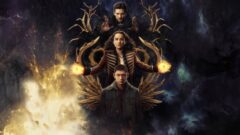Season 3 of Apple TV’s For All Mankind races to the Red Planet and The Third Floor (TTF) was thrilled to be part of the journey! From the show’s inception, visualization has been a part of the process used on the series to develop believable storytelling set both in space and on the ground.
From shots up in orbit to full action scenes across multiple locations on Mars, TTF collaborated closely with VFX Supervisor Jay Redd and others to build assets and visualize sequences in previs, sometimes working from sketches and sometimes from detailed descriptions. TTF artists, led on the project by Visualization Supervisors Juan C. Vargas and Barry Howell, also produced visual tests, techvis and postvis to help evolve ideas as shots and concepts went into filming and post.
“The most challenging aspect of this project was making sure what was visualized was as accurate as possible technically and physically” Vargas said. “We had an astronaut as a consultant, helping advise what would be correct for a given scenario per dynamics of space exploration in the real world.”
In a big action scene earlier in Season 3, a space hotel experiences an issue that makes them spin out of control, prompting a perilous rescue operation. Interior plate photography would need to have actors experiencing the rotating rooms and looking out windows with continuity to the hotel’s position over Earth. Cutaways to wide digital shots also needed to follow believable motion and physics, with defined positioning in space and to the earth. Building a hotel asset in 3D and running it through multiple simulations, TTF completed a large assortment of visual tests to help inform speed, velocity and surface/window views as the filming strategy and visual effects content of the scene were planned.
“The client needed to be able to envision what it would look like from various positions inside the hotel as it spun around,” Visualization Supervisor Vargas recalled. “Differing speeds of revolution and different angles of orbit were experimented with to arrive at an optimal spin speed that would be as accurate as possible without being nausea inducing to viewers. These details needed to be figured out long before shooting began, as the orientation would completely drive the lighting setup for every single shot, as the lighting would have to revolve around the set at the right speed and angle to match the hotel’s position and rotation speed.”
During Season 3, the U.S., Russia and a commercial company launch ships to Mars. Several sequences highlight the spacecraft designs and tech that make the missions possible, along with systems and solutions the characters leverage as they land and engage with new challenges on Mars.
“An amazing thing on this show is being able to work with the series team to experiment with ways of traveling to Mars that are based on actual theoretical ideas for Mars travel,” says Howell. ”In a way, it was as if we were previsualizing future possible NASA expeditions towards the Red Planet.”
TTF’s AR app Cyclops was used on the production to build a virtual Mars landscape that could be called up during discussion meetings and shown to actors and crew as a way to see CG VFX that would extend beyond the constructed sets. Built by Redd by ingesting hundreds of acres of scanned topography, the Cyclops Mars asset also allowed story locations to be scouted and pinpointed.
“Through Cyclops, they built a detailed Mars-scape that could literally be taken around to meetings or to set and viewed in real time whenever there were questions about what the actors or what cameras would see around them. They could map out the story geography on Mars, and use the virtual model to establish locations where key events would happen, where base and landing sites would be and so on. Background snapshots from Cyclops also helped fill in the blanks during editorial prior to completion of final VFX.”








